 W
WA balisong, also known as a fan knife, butterfly knife or Batangas knife, is a folding pocketknife from the Philippines. Its distinct features are two handles counter-rotating around the tang such that, when closed, the blade is concealed within grooves in the handles. A latch holds the handles together, typically mounted on the one facing the cutting edge.
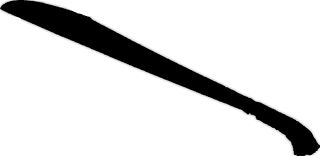 W
WThe bangkung or bangkon, is a short sword originating in the Sulu Archipelago of the Philippines. The bangkung was used primarily by the Moro people of the Sulu and is not associated with Moros in other areas such as Mindanao, although it is sometimes found in coastal regions. The bangkung is a slashing weapon, meant to deliver hacking type blows. While the bangkung is a very effective sword, it was not popular unlike the panabas and the pirah and for this reason it is one of the most rarely found Moro edged weapons. Few were produced and even fewer survive.
 W
WThe barong is a thick, leaf-shaped, single-edged blade sword. It is a weapon used by Muslim Filipino ethnolinguistic groups like the Tausug, Sama-Bajau, or Yakan in the Southern Philippines.
 W
WThe baston is one of the primary weapons of Arnis and Filipino martial arts. It is also known as yantok, olisi, palo, pamalo, garrote, caña, cane, arnis stick, eskrima stick or simply, stick.
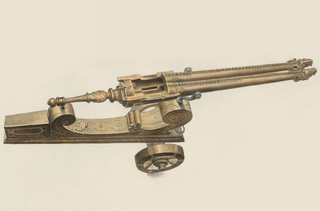 W
WThe Cetbang was a type of cannon produced and used by the Majapahit Empire (1293–1527) and other kingdoms in the Indonesian archipelago. The cetbang is a breech-loading cannon, it is different from typical European and Middle Eastern cannons, which are usually muzzleloader. In the Sekar inscription it states that the main production foundries of cetbang were in Rajekwesi, Bojonegoro, whereas the black powder was produced in Swatantra Biluluk (Lamongan).
 W
WThe Dahong Palay, literally "rice leaf" in Tagalog, is a single-edged sword from the Philippines, specifically the Southern Tagalog provinces of Batangas and Mindoro. The sword's name could either be a reference to the similarity of its shape to the leaves of rice or to local green snakes "dahong palay", purported to be extremely venomous. The snake is probably green specimens of the Philippine Pit Viper, Trimeresurus flavomaculatus, though it is sometimes identified as various relatively harmless green snakes, like vine snakes. The dahong palay was originally used as a farmer's tool, for clearing thick grass growths. However, during the Philippine revolution of 1896, farmers from Batangas soon came to favor it for its slashing and thrusting "feel".
 W
WThe 10" Personal Defense Weapon (PDW) is a proposed automatic rifle made by the Government Arsenal of the Philippines, based on the M4 carbine/M16 rifle. It cycles fully automatic with specially developed 7.62×37mm Musang subsonic and supersonic rounds.
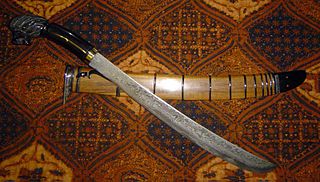 W
WA golok is a cutting tool, similar to a machete, that comes in many variations and is found throughout the Indonesian archipelago. It is used as an agricultural tool as well as a weapon. The word golok is of Indonesian origin, but is also used in Malaysia and in the Philippines. Both in Malaysia and in Indonesia, the term is usually interchangeable with the longer and broader parang. In the Sundanese region of West Java it is known as bedog.
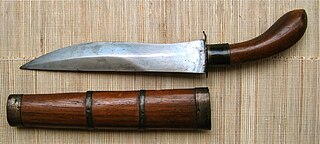 W
WThe gunong is a knife from Mindanao and the Visayas islands of the Philippines. In ancient past, it was called bunong by the Tagalog people. It is essentially a diminutive form of the larger kalis or kris. The gunong serves both as a utility knife and as a thrusting weapon used for close quarter fighting—usually as a last defense. It is most often associated with the Maranao, among whom the gunong was traditionally carried by both sexes, although it exists in other cultures throughout Mindanao and the Visayas. The weapon is generally tucked into the back of a waist sash.
 W
WIstinggar is a type of matchlock firearm built by the various ethnic groups of Nusantara archipelago. The firearms is a result of Portuguese influence to local weaponry, particularly after the capture of Malacca (1511). Before this type of gun, in the archipelago already existed primitive long gun called bedil, or Java arquebus as the Chinese call it.
 W
WThe kalasag is a large rectangular myth-motif shield used by the natives in the Philippines. The shield is made of hardwood and is decorated with elaborate carvings. The wood comes from native trees such as the dapdap, polay and sablang. The shield measured about 1.5 m (4.9 ft) in length. Its base is composed of rattan wood which is strengthened by the application of resin.
 W
WA kalis is a type of double-edged Filipino sword, often with a "wavy" section, similar to a keris. Just like the keris, the kalis's double-edged blade can be used for both cutting and thrusting; except that the kalis is much larger than most keris, making it a sword rather than a dagger.
 W
WThe kampilan is a type of single-edged sword, traditionally used by various ethnic groups in the Philippine archipelago. It has a distinct profile, with the tapered blade being much broader and thinner at the point than at its base, sometimes with a protruding spikelet along the flat side of the tip. The design of the pommel varies between ethnic groups, but it usually depicts either a bakunawa (dragon), a buaya (crocodile), a kalaw (hornbill), or a kakatua (cockatoo).
 W
WLantaka or rentaka was a type of bronze portable cannon or swivel gun, sometimes mounted on merchant vessels and warships in Maritime Southeast Asia. It was commonly equipped by native seafaring vessels from the Philippines, Indonesia, Brunei, and Malaysia. Rentaka and lela is known by the Malays as meriam kecil, the difference is that rentaka is smaller in length and bore than a lela.
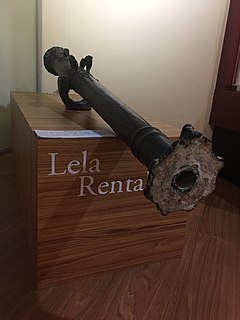 W
WLela or lila is a type of Malay cannon, used widely in the Nusantara archipelago. They are similar to a lantaka but longer and had larger bore. Lela can be configured as swivel gun, fixed gun, or mounted in a gun carriage. It is the equivalent of European falcon and falconet.
 W
WThis is the list of the Weapons used in the Philippine revolution.
 W
WThe Marine Scout Sniper Rifle or MSSR is a semi-automatic designated marksman rifle developed from the Colt M16A1 rifle by the Philippine Marine Corps Scout Snipers due to the lack of a dedicated precision rifle which is used in the Armed Forces of the Philippines.
 W
WThe panabas, also known as nawi, is a large, forward-curved sword or battle axe used by certain ethnic groups in the southern Philippines. It can range in size from 2 to 4 feet and can be held with one or both hands, delivering a deep, meat cleaver-like cut. In its heyday, it was used as a combat weapon, as an execution tool, and as a display of power. Occasional use as an agricultural and butchering tool has also been noted.
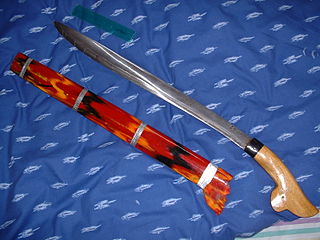 W
WThe parang is a type of knife used across the Malay archipelago. It is often mistakenly assumed to be a sword; however, there is no evidence that it has ever been used in a formal military conflict, nor that its intended purpose was to be used as a combat weapon. Although some may argue that it could be called a machete or a chopper as it is a direct variation of the modern machete, its academic status remains as a knife.
 W
WSibat is the Filipino word for spear, used as a weapon or tool by natives of the Philippines. The term is used in Tagalog and Kinaray-a. It also called bangkaw, sumbling or palupad in the islands of Visayas and Mindanao; and budjak among Muslim Filipinos in western Mindanao and the Sulu Archipelago.
 W
WThe Special Operations Assault Rifle (SOAR) is an assault rifle manufactured by FERFRANS and designed as an improvement of the M4 carbine.
 W
WA Taming is a shield traditionally used by the Moro of the Philippines. It is made of tightly woven rattan. Its origin is uncertain: various scholars suggest it comes from Maranaos, Chinese, Moluccan, or Spanish. In Indonesian language, Tameng is a general term for shield.
 W
W"Weapons of Moroland" is a plaque or crest containing miniature models of weapons used by warriors from the indigenous peoples of Mindanao in the Philippines. As a souvenir, it is fairly common in gift shops, and is considered a pop culture icon. Displaying the plaque in one's home is one of several indications of "how Filipino" one is. It is jokingly used as a description of resistance to colonialism.